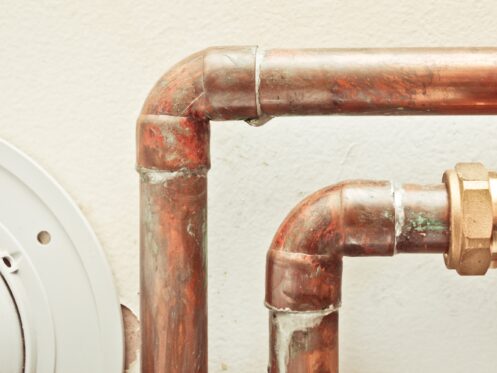Do you have an older home and some concerns about the condition of your plumbing system? Certain plumbing problems are much more common with an older system and can be a nightmare to deal with.
Let’s explore some of the common problems associated with older plumbing systems and discuss the options available for preventing and addressing them.
Leaks and Water Damage
Any plumbing system can develop an issue that leads to a leak in a water line or drainpipe. Nonetheless, older ones are typically much more prone to leaks as a result of old and deteriorated pipes.
Rust and corrosion can eventually eat through old metal pipes and make them leak. The solder joints that connect metal pipes and the glue that connects PVC pipes also deteriorate over time and can lead to both minor and major leaks.
The main concern with plumbing leaks is that they have the potential to do extensive water damage in a fairly short period. This is one reason why regular inspections are important if your home has older plumbing, as they can help identify any potential issues. Call for leak detection as soon as you notice any signs like water damage behind walls or skyrocketing water bills. Replacing your old water lines or upgrading from cast iron to PVC drainpipes is an effective solution for preventing major issues and avoiding huge repair bills in the future.
Frequent Clogs and Slow Drains
Clogs and slow drains are other common issues with old plumbing systems. Cast iron drainpipes and sewer lines often get choked off by rust and corrosion building up inside them. This then leads to them not draining properly, causing debris to get left behind and eventually creating a clog. Mineral deposit buildup from hard water inside pipes can create the same sort of issue.
That’s one of the many reasons why installing a water softener can be so beneficial, as it will eliminate the minerals in your water and prevent deposits and limescale from forming. Having your drains cleaned regularly is also important for eliminating debris and all types of buildup to further reduce the chances of drain and sewer issues.
Low Water Pressure
Low or frequently fluctuating water pressure are both quite common with older plumbing systems as well. These issues are often a result of mineral deposits, rust and corrosion inside water lines. This type of buildup shrinks the inside of pipes over time, so that less water can flow through them, and the water pressure decreases.
You may not have much of an issue when only one plumbing fixture is in use, but you can end up with a fairly significant drop in pressure whenever multiple fixtures are using water at the same time. Installing a pressure-boosting pump is one way to help with this type of issue. However, repiping is always the most effective long-term solution.
High Water Bills
Outdated plumbing and old plumbing fixtures also often lead to your water bills being much higher. For instance, you can end up with a substantial amount of water being wasted as a result of something like an old faucet that constantly drips or a worn-out component causing a toilet to frequently run. A running toilet can be an especially big problem, as it could easily waste thousands of gallons of water per month.
Replacing outdated plumbing fixtures with low-flow models is one of the easiest ways to save money by reducing your household’s water usage. Federal law has required the use of low-flow faucets in kitchens and bathrooms and low-flush toilets in bathrooms since 1992.
Nonetheless, many people continue to stick with their old, inefficient faucets and toilets out of fear that low-flow models don’t work nearly as well. It’s a common misconception that you have to flush a low-flow toilet multiple times to get everything to go down. This was sometimes the case when low-flow toilets were introduced, but newer models are far better and almost never have this issue.
Low-flow faucets use no more than 2.2 gallons of water per minute, whereas old faucets often use 3 to 4 gallons per minute. Upgrading to a reduced-flow showerhead that meets the EPA’s WaterSense standards is another great option. In fact, estimates show that it could reduce the average family’s water usage by around 2,700 gallons per year.
Toilets produced in the mid-1980s or earlier can easily use 5+ gallons per flush and waste a huge amount of water. Even toilets made until the early 1990s when the new requirement went into place often use at least 3.5 gallons per flush. Any low-flush toilet you install will use 1.6 gallons per flush at the most, while high-efficiency toilets use only around 1.3 gallons.
Since toilets are flushed so many times a day, you can greatly reduce your water usage by replacing those old, inefficient ones. One option you should definitely consider when upgrading a toilet is to choose a dual-flush model. This type of toilet has one flush level designed for solids and a second level, designed for liquids, that uses substantially less water.
Poor Water Quality
One issue you always need to be concerned about is contaminated water. Contaminants and pollutants can enter your home’s water supply in a variety of ways, such as through cracks in the municipal water mains.
Water that has gone through the local water treatment plant can still contain contaminants like pesticides, fertilizers, and pharmaceuticals. This is part of the reason why installing a water filtration system in your home is such a good idea — it will eliminate all the contaminants and ensure that your water is clean.
The only concern is that a filtration system may not always help when the contaminants originate from within your plumbing system. Some old homes still have lead or galvanized steel pipes, both of which result in water getting highly contaminated due to lead leaching out of the pipes. In this case, we highly recommend having your home repiped as soon as you can to eliminate all the health risks lead poses.
Inefficient Water Heating
A substantial percentage of newer homes have a tankless water heater instead of a traditional tank unit. One reason for this is that tankless units provide hot water on demand, so your hot water never runs out.
The other major reason so many people now opt for tankless water heaters is that they are more energy efficient and cost quite a bit less to run. Installing a tankless water heater is yet another plumbing upgrade that can really pay off. Not only will it almost certainly help lower your gas or electricity bills, but it should also last at least a few years more than even the best traditional water heater.
If you’re sick of dealing with frequent plumbing issues or are looking for any type of upgrade, O'Boys Plumbing, Heating & Air is ready to help. Our family-owned and -operated business is dedicated to providing effective, reliable plumbing solutions to homeowners in Blaine, MN and the surrounding areas.
From installing water softeners, water heaters, and filtration systems to repairs and drain cleaning, you can count on us for all of your needs.
To schedule a service call, inspection, or consultation with one of our plumbing experts, contact O'Boys Plumbing, Heating & Air today.

